Vector Algebra Class 12th Notes - Free NCERT Class 12 Maths Chapter 10 Notes - Download PDF
Hey, looking for notes that make vectors as easy as arrows on paper? Check out these Vector Algebra Notes! Step into a world where direction meets calculation—Vector Algebra simplifies the forces and motions that shape our universe. Vector algebra is the mathematics of navigation, physics, and the hidden forces around us. Have you ever wondered how a pilot navigates a plane in the right direction and speed? Or during sports commentary, how they calculate the trajectory of a ball. These are all applications of vector algebra, which we covered in the NCERT Notes for Class 12 Maths. A vector is a quantity which has magnitude as well as direction. In these NCERT Class 12 Maths Chapter 10 Notes, students will learn about vectors, representation, position vector, magnitude, types of vectors, addition and multiplication of vectors, components of vectors, direction cosines, and other properties.
This Story also Contains
- Vector Algebra Class 12 Notes Free PDF Download
- NCERT Notes for Class 12 Chapter 10 Vector algebra
- How to Use the Vector Algebra Class 12 Notes Effectively?
- Vector Algebra Class 12 Notes: Previous Year Question and Answer
- NCERT Class 12 Maths Notes Chapter-Wise Links
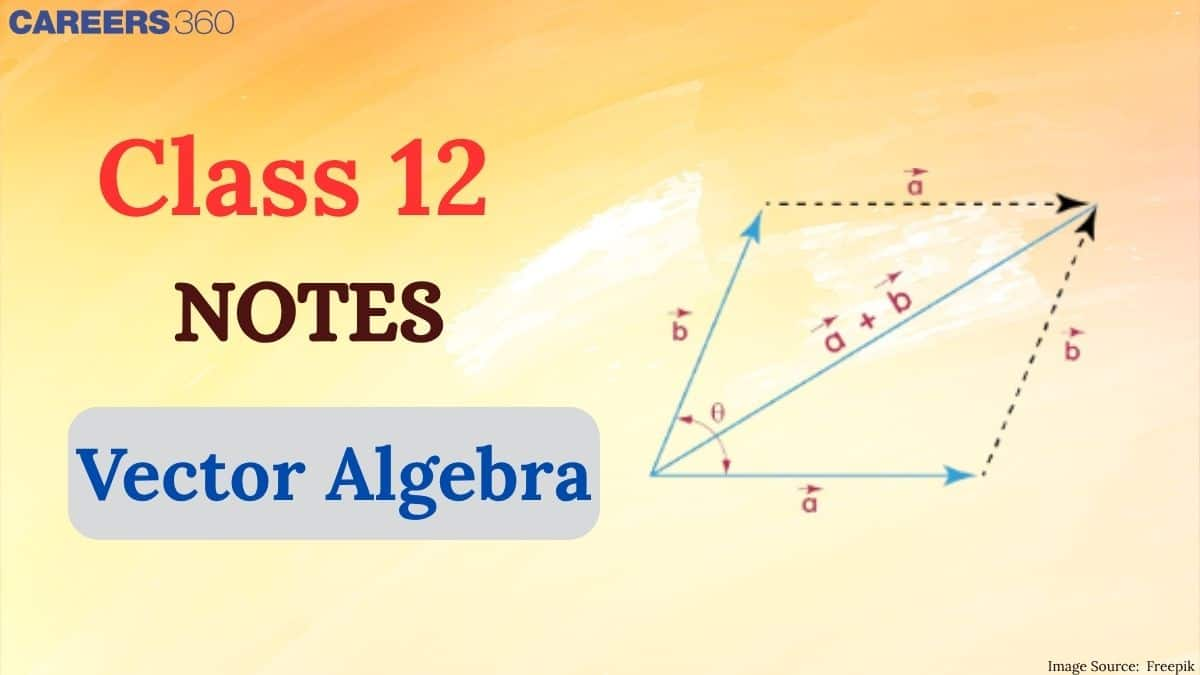
Mastering vector algebra is like learning to navigate the map of multidimensional space. After completing the textbook solutions, students need a proficient study material for quick revision. That is when the Vector Algebra Class 12 NCERT notes come into play. Careers360 experts meticulously prepare these notes, covering all important topics, formulas, and examples thoroughly. Find everything in one place – NCERT Books, Solutions, Syllabus, and Exemplar Problems with Solutions – in this NCERT article.
Also, read,
Vector Algebra Class 12 Notes Free PDF Download
Careers360 has prepared these NCERT Class 12 Maths Chapter 10 Notes to make your revision smoother and faster. A downloadable PDF is also available.
NCERT Notes for Class 12 Chapter 10 Vector algebra
Careers360 brings you NCERT Class 12 Maths Chapter 10 Notes, carefully prepared by subject experts to simplify your studies and help in exams.
Vectors: Quantities that have both magnitude and direction and follow vector addition laws are called vectors.
Denoted by: $\overrightarrow{A B}$
Scalars: Quantities that have only magnitude but no direction are called scalars.
Example for Vectors and Scalars:
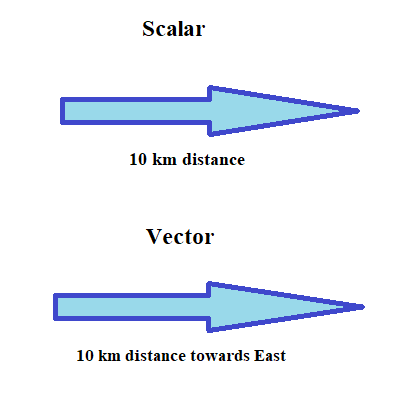
The magnitude of the vector: This shows the value of the vector and is denoted by: $|\overrightarrow{A B}|$
Representation of a Vector
A vector is represented by a directed line segment (an arrow). The endpoints of the segment are called the initial point and the terminal point of the vector. An arrow from the initial point to the terminal point indicates the direction of the vector.

Position Vector: Let $\mathrm{O}(0,0,0)$ be the origin and $\mathrm{P}(\mathrm{x}, \mathrm{y}, \mathrm{z})$ be the position vector.
Then the magnitude of a vector is denoted by: $|\overrightarrow{O P}|$
Formula: $|\overrightarrow{O P}|=\sqrt{x^2+y^2+z^2}$
Direction Cosines
Let $r$ be the position vector of a point $P(x, y, z)$. Then, the direction cosines of vector $r$ are the cosines of angles $\alpha, \beta$, and $y$ (i.e. $\cos \alpha$, $\cos \beta$, and $\cos \gamma$ ) that the vector $r$ makes with the positive direction of $X, Y$, and $Z$-axes respectively. Direction cosines are usually denoted by $I, m$, and $n$, respectively.

From the figure, note that ΔOAP is a right-angled triangle, and thus, we have
$
\cos \alpha=\frac{x}{r}(r \text { stands for }|r|)
$
Similarly, from the right angled triangles $O B P$ and $O C P$, We have,
$
\cos \beta=\frac{y}{r} \text { and } \cos \gamma=\frac{z}{r}
$
So we have the following results,
$
\begin{aligned}
& \cos \alpha=l=\frac{x}{\sqrt{x^2+y^2+z^2}}=\frac{x}{|\mathbf{r}|}=\frac{x}{r} \\
& \cos \beta=m=\frac{y}{\sqrt{x^2+y^2+z^2}}=\frac{y}{|\mathbf{r}|}=\frac{y}{r} \\
& \cos \gamma=n=\frac{z}{\sqrt{x^2+y^2+z^2}}=\frac{z}{|\mathbf{r}|}=\frac{z}{r}
\end{aligned}
$

Also,
$
\begin{aligned}
& l^2=\frac{x^2}{x^2+y^2+z^2} \\
& m^2=\frac{y^2}{x^2+y^2+z^2} \\
& n^2=\frac{z^2}{x^2+y^2+z^2}
\end{aligned}
$
Add (i), (ii) and (iii)
$
\begin{aligned}
& l^2+m^2+n^2=\frac{x^2}{x^2+y^2+z^2}+\frac{y^2}{x^2+y^2+z^2}+\frac{z^2}{x^2+y^2+z^2} \\
& \Rightarrow l^2+m^2+n^2=1 \\
& \Rightarrow \cos ^2 \alpha+\cos ^2 \beta+\cos ^2 \gamma=1
\end{aligned}
$
The coordinates of the point P may also be expressed as (lr, mr, nr).
Types of vectors
- Zero vector: A vector whose magnitude is zero is called a Zero vector. It is denoted by $|\overrightarrow{0}|$.
- Unit Vector: A vector whose magnitude is equal to one is called a Unit vector.
$a=\frac{\vec{a}}{|\vec{a}|}$ - Coinitial Vectors: Two or more vectors are called coinitial if they have the same initial point.

- Collinear Vectors: If two vectors are parallel to a given line, then the vectors are called collinear.

- Equal Vectors: The vectors that have the same magnitude and equal direction such vectors are called Equal vectors.
$|\vec{a}|=|\vec{b}|$ - Negative of a Vector: Vectors whose magnitude is the same but opposite in direction are called negative vectors.
$|\overrightarrow{A B}|=|-\overrightarrow{B A}|$
Addition of vectors
Triangle law of addition
If two vectors are represented in the same direction and the resultant is represented in the opposite direction, that is called the Triangle Law of addition.
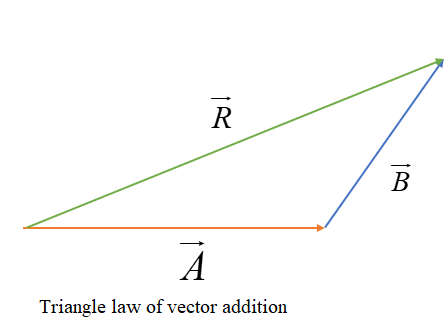
Parallelogram law of vector addition:
If two vectors are adjacent sides of the parallelogram, then the resultant vector is the diagonal of the parallelogram.
$|\overrightarrow{O A}|+|\overrightarrow{O C}|=|\overrightarrow{O B}|$
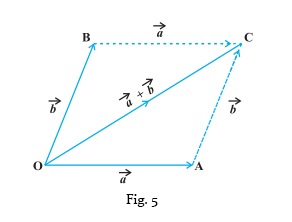
Properties of vector addition
Commutative: $\vec{a}+\vec{b}=\vec{b}+\vec{a}$
Associative: $(\vec{a}+\vec{b})+\vec{c}=\vec{a}+(\vec{b}+\vec{c})$
Additive identity: $\vec{a}+\overrightarrow{0}=\vec{a}$
Additive inverse: $\vec{a}+(-\vec{a})=\overrightarrow{0}$
Multiplication of a Vector by a Scalar
Where $\vec{a}$ denotes a vector and $\lambda$ denotes a scalar.
The magnitude of $|\lambda \cdot \vec{a}|=|\lambda| \cdot|\vec{a}|$
Properties of Multiplication of Vectors
(a) $\alpha(\vec{a}+\vec{b})=\alpha \vec{a}+\alpha \vec{b}$
(b) $(\alpha+\beta) \vec{a}=\alpha \vec{a}+\beta \vec{a}$
(c) $\alpha(\beta \vec{a})=(\alpha \beta) \vec{a}$
Components of Vectors
Let the position vector be $|\overrightarrow{O P}|=\vec{r}=x \hat{i}+y \hat{j}+z \hat{k}$ is a component of the vector.
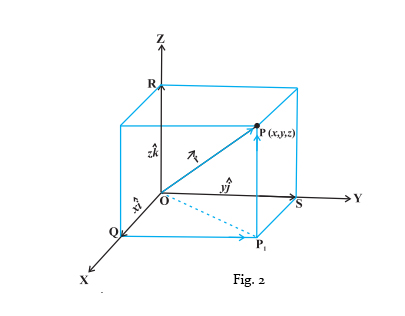
Two Dimensions:
$
\begin{aligned}
& \overrightarrow{O P}=x \hat{i}+y \hat{j} \\
& ⇒|\overrightarrow{O P}|=\sqrt{x^2+y^2}
\end{aligned}
$
Three Dimension:
$\overrightarrow{OP}= x\hat{i}+y\hat{j}+z\hat{k}$
$⇒ \overrightarrow{OP}=\sqrt{x^2+y^2+z^2}$
Vectors joining two Points
$P_1\left(x_1, y_1, z_1\right)$ and $\mathrm{P}_2\left(x_2, y_2, z_2\right)$ are any points on the axis.
Vector joining $P_1$ and $\mathrm{P}_2$ is given below:
$
\begin{aligned}
& \overrightarrow{P_1 P_2}=\left(x_2-x_1\right) \hat{i}+\left(y_2-y_1\right) \hat{j}+\left(z_2-z_1\right) \hat{k} \\
&⇒ \left|\overrightarrow{P_1 P_2}\right|=\sqrt{\left(x_2-x_1\right)^2+\left(y_2-y_1\right)^2+\left(z_2-z_1\right)^2}
\end{aligned}
$
Section Formula: $\overrightarrow{O P}$ be a position vector and line segment $A B$
- Divided internally in m:n ratio, then the formula is $\overrightarrow{O P}=\frac{m \vec{b}+n \vec{a}}{m+n}$
- Divided externally in the m:n ratio, the formula is $\overrightarrow{O P}=\frac{m \vec{b}-n \vec{a}}{m-n}$
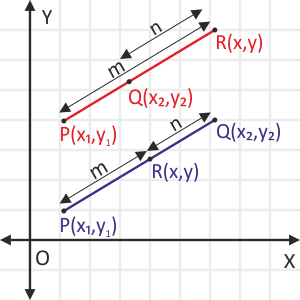
Midpoints of vectors: $\overrightarrow{O P}=\frac{\vec{a}+\vec{b}}{2}$
Dot (scalar) Product
If $\overrightarrow{\mathbf{a}}$ and $\overrightarrow{\mathbf{b}}$ are two non-zero vectors, then their scalar product (or dot product) is denoted by $\overrightarrow{\mathbf{a}} \cdot \overrightarrow{\mathbf{b}}$ and is defined as
Observations:
1. $\quad \vec{a} \cdot \vec{b}$ is a real number.
2. $\quad \vec{a} \cdot \vec{b}$ is positive if $\theta$ is acute.
3. $\quad \vec{a} \cdot \vec{b}$ is negative if $\theta$ is obtuse.
4. $\quad \vec{a} \cdot \vec{b}$ is zero if $\theta$ is $90^{\circ}$.
5. $\quad \vec{a} \cdot \vec{b} \leq|\vec{a}||\vec{b}|$
For any two non-zero vectors $\overrightarrow{\mathbf{a}}$ and $\overrightarrow{\mathbf{b}}$, then $\overrightarrow{\mathbf{a}} \cdot \overrightarrow{\mathbf{b}}=0$ if and only if $\overrightarrow{\mathbf{a}}$ and $\overrightarrow{\mathbf{b}}$ perpendicular to each other. i.e.
$
\overrightarrow{\mathbf{a}} \cdot \overrightarrow{\mathbf{b}}=0 \Leftrightarrow \overrightarrow{\mathbf{a}} \perp \overrightarrow{\mathbf{b}}
$
As $\hat{\mathbf{i}}, \hat{\mathbf{j}}$ and $\hat{\mathbf{k}}$ are mutually perpendicular unit vectors along the coordinate axes, therefore,
$
\hat{\mathbf{i}} \cdot \hat{\mathbf{j}}=\hat{\mathbf{j}} \cdot \hat{\mathbf{i}}=0, \hat{\mathbf{j}} \cdot \hat{\mathbf{k}}=\hat{\mathbf{k}} \cdot \hat{\mathbf{j}}=0 ; \hat{\mathbf{k}} \cdot \hat{\mathbf{i}}=\hat{\mathbf{i}} \cdot \hat{\mathbf{k}}=0
$
If $\theta=0$, then $\overrightarrow{\mathbf{a}} \cdot \overrightarrow{\mathbf{b}}=|\vec{a}||\vec{b}|$
In particular, $\overrightarrow{\mathbf{a}} \cdot \overrightarrow{\mathbf{a}}=|\overrightarrow{\mathbf{a}}|^2$
As $\hat{\mathbf{i}}, \hat{\mathbf{j}}$ and $\hat{\mathbf{k}}$ are unit vectors along the coordinate axes, therefore
$
\hat{\mathbf{i}} \cdot \hat{\mathbf{i}}=|\hat{\mathbf{i}}|^2=1, \hat{\mathbf{j}} \cdot \hat{\mathbf{j}}=|\hat{\mathbf{j}}|^2=1 \text { and } \hat{\mathbf{k}} \cdot \hat{\mathbf{k}}=|\hat{\mathbf{k}}|^2=1
$
Properties of Dot (Scalar) Product
1. $\quad \overrightarrow{\mathbf{a}} \cdot \overrightarrow{\mathbf{b}}=\overrightarrow{\mathbf{b}} \cdot \overrightarrow{\mathbf{a}} \quad$ ( commutative )
2. $\overrightarrow{\mathbf{a}} \cdot(\overrightarrow{\mathbf{b}}+\overrightarrow{\mathbf{c}})=\overrightarrow{\mathbf{a}} \cdot \overrightarrow{\mathbf{c}}+\overrightarrow{\mathbf{a}} \cdot \overrightarrow{\mathbf{c}} \quad$ (distributive)
3. $\quad(m \overrightarrow{\mathbf{a}}) \cdot \overrightarrow{\mathbf{b}}=m(\overrightarrow{\mathbf{a}} \cdot \overrightarrow{\mathbf{b}})=\overrightarrow{\mathbf{a}} \cdot(m \overrightarrow{\mathbf{b}}) ;$ where $m$ is a scalar and $\vec{a}, \vec{b}$ are any two vectors
4. $\quad(l \overrightarrow{\mathbf{a}}) \cdot(m \overrightarrow{\mathbf{b}})=\operatorname{lm}(\overrightarrow{\mathbf{a}} \cdot \overrightarrow{\mathbf{b}})$; where $l$ and $m$ are scalars
For any two vectors $\overrightarrow{\mathbf{a}}$ and $\overrightarrow{\mathbf{b}}$, we have
(i)
$
\begin{aligned}
|\vec{a} \pm \vec{b}|^2 & =|\vec{a} \pm \vec{b}| \cdot|\vec{a} \pm \vec{b}| \\
& =|\vec{a}|^2+|\vec{b}|^2 \pm 2 \vec{a} \cdot \vec{b} \\
& =|\vec{a}|^2+|\vec{b}|^2 \pm 2|\vec{a}||\vec{b}| \cos \theta
\end{aligned}
$
(ii) $|\vec{a}+\vec{b}| \cdot|\vec{a}-\vec{b}|=|\vec{a}|^2-|\vec{b}|^2$
(iii) $|\vec{a}+\vec{b}|=|\vec{a}|+|\vec{b}| \Rightarrow \vec{a}$ and $\vec{b}$ are like vectors
(iv) $|\vec{a}+\vec{b}|=|\vec{a}-\vec{b}| \Rightarrow \vec{a} \perp \vec{b}$
- If $\vec{a}=a_1 \hat{i}+a_2 \hat{j}+a_3 \hat{k}$ and $\vec{b}=b_1 \hat{i}+b_2 \hat{j}+b_3 \hat{k}$,
then $\vec{a} \cdot \vec{b}=a_1 b_1+a_2 b_2+a_3 b_3$. - If $\vec{a}, \vec{b}$ are non-zero, the angle between them can be given by:
$\cos \theta=\frac{\vec{a} \cdot \vec{b}}{|\vec{a}| \cdot|\vec{b}|}=\frac{a_1 b_1+a_2 b_2+a_3 b_3}{\sqrt{a_1^2+a_2^2+a_3^2} \cdot \sqrt{b_1^2+b_2^2+b_3^2}}$
Projection of a vector along another vector
Projection of $\vec{a}$ on $\vec{b}$ is given by: $\frac{\vec{a} \cdot \vec{b}}{|\vec{b}|}$
Projection of $\vec{b}$ on $\vec{a}$ is given by: $\frac{\vec{a} \cdot \vec{b}}{|\vec{a}|}$
If $\theta=0,$ projection of $\overrightarrow{A B}$ will be $\overrightarrow{A B}$ only.
If $\theta=\pi,$ projection of $\overrightarrow{A B}$ will be $\overrightarrow{B A}$.
If $\theta=\frac{\pi}{2}$ or $\frac{3 \pi}{2},$ projection of $\overrightarrow{A B}$ will be zero.
Cross Product
$\theta$ is the angle between two non-parallel vectors $\vec{a}$ and $\vec{b}$, then the cross product is given by $\vec{a} \times \vec{b}$.
Formula : $\vec{a} \times \vec{b}=|\vec{a}||\vec{b}| \sin \theta$
Property of Cross Product
The cross product is defined as
$
\vec{a} \times \vec{b}=(|\vec{a}||\vec{b}| \sin \theta) \hat{n}
$
where $\hat{n}$ is the unit vector orthogonal to both $\hat{a}$ and $\hat{b}$ following the right-hand rule for direction, and $\theta$ is angle between the vectors.
$
\begin{aligned}
& \text {If } \vec{a}=\left[a_1, a_2, a_3\right] \text { and } \vec{b}=\left[b_1, b_2, b_3\right] \text { then } \\
& \vec{a} \times \vec{b}=\left[a_2 b_3-a_3 b_2, a_3 b_1-a_1 b_3, a_1 b_2-a_2 b_1\right]
\end{aligned}
$
The magnitude of the cross product vector is:
$
|\vec{a} \times \vec{b}|=|\vec{a}||\vec{b}| \sin \theta
$
which also calculates the area of the parallelogram defined by $\vec{a}$ and $\vec{b}$
The angle $\theta$, between two vectors, $\vec{a}$ and $\vec{b}$ is given by:
$
\theta=\sin ^{-1}\left(\frac{|\vec{a}| \times|\vec{b}|}{|\vec{a}| \cdot|\vec{b}|}\right)
$
For any vectors $\vec{a}, \vec{v}$ and $\vec{w}$ and scalar $\mathrm{k} \in \mathbb{R}$
$
\begin{aligned}
& \vec{u} \times \vec{v}=-(\vec{v} \times \vec{u}) \\
& \vec{u} \times(\vec{v}+\vec{w})=\vec{u} \times \vec{v}+\vec{u} \times \vec{w} \\
& (\vec{u}+\vec{v}) \times \vec{w}=\vec{u} \times \vec{w}+\vec{v} \times \vec{w}
\end{aligned}
$
If $\vec{u}$ and $\vec{v}$ are non zero, $\vec{u} \times \vec{v}=0$
if and only there is a scalar $\mathrm{m} \in \mathbb{R}$ such that $\vec{u}=m \vec{v}$
$
k(\vec{u} \times \vec{v})=(k \vec{u}) \times \vec{v}=\vec{u} \times(k \vec{v})
$
How to Use the Vector Algebra Class 12 Notes Effectively?
Vector Algebra is an important chapter of Class 12 Maths that helps us understand how quantities with both magnitude and direction are used in calculations. It is very useful for solving physics-related problems and for 3D Geometry. This chapter is important for JEE, and using Class 12 Maths chapter 10 notes properly can make vector questions much easier. Here are some more points on how these notes are important.
- Start by learning the basic concepts and types of vectors, as these ideas form the base of the chapter.
- Practice vector addition, scalar multiplication, and vector products regularly, as these are common in exams.
- This chapter is useful in higher classes and physics too, so revising with these NCERT Class 12 Maths chapter 10 notes will strengthen your understanding.
- Solve NCERT examples and exercises to get comfortable with different types of vector problems.
Vector Algebra Class 12 Notes: Previous Year Question and Answer
Given below are selected previous year question answers for NCERT Class 12 Maths Chapter 10 Vector algebra, collected from various examinations.
Question 1:
Let $\overrightarrow{\mathrm{a}}=\hat{\mathrm{i}}+2 \hat{\mathrm{j}}+\hat{\mathrm{k}}$ and $\overrightarrow{\mathrm{b}}=2 \hat{\mathrm{i}}+\hat{\mathrm{j}}-\hat{\mathrm{k}}$. Let $\hat{\mathrm{c}}$ be a unit vector in the plane of the vectors $\vec{a}$ and $\vec{b}$, and perpendicular to $\vec{a}$. Then such a vector $\hat{\mathbf{c}}$ is:
Solution:
$\begin{aligned} & \vec{c}=x \vec{a}+y \vec{b} \\ & \vec{c}=x(\hat{i}+2 \hat{j}+\hat{k})+y(2 \hat{i}+\hat{j}-\hat{k}) \\ & \vec{a} \cdot \vec{c}=(\hat{i}+2 \hat{j}+\hat{k}) \cdot(x(\hat{i}+2 \hat{j}+\hat{k})+y(2 \hat{i}+\hat{j}-\hat{k})) \\ & (\hat{i}+2 \hat{j}+\hat{k}) \cdot(x \hat{i}+2 x \hat{j}+x \hat{k})+2 y \hat{i}+y \hat{j}-y \hat{k}=0 \\ & \Rightarrow \quad(x+2 y)+2(x+9)+(x-y)=0 \\ & \Rightarrow \quad y=-2 x \\ & \therefore \quad \vec{c}=x(-3 \hat{i}+3 \hat{k}) \\ & |\vec{c}|=|x| \sqrt{9+9}=3|x| \sqrt{2} \\ & \therefore|\vec{c}|=1 \\ & 3|x| \sqrt{2}=1 \\ & |x|=\frac{1}{3 \sqrt{2}} \\ & \text { Let } x=\frac{1}{3 \sqrt{2}} \\ & \vec{c}=\frac{1}{3 \sqrt{2}}(-3 \hat{i}+3 \hat{k}) \\ & ⇒ \vec{c}=\frac{1}{\sqrt{2}}(-\hat{i}+\hat{k})\end{aligned}$
Hence, the correct answer is $\frac{1}{\sqrt{2}}(-\hat{\mathrm{i}}+\hat{\mathrm{k}})$.
Question 2:
Let $\vec{a}$ and $\vec{b}$ be the vectors of the same magnitude such that $\frac{|\vec{a}+\vec{b}|+|\vec{a}-\vec{b}|}{|\vec{a}+\vec{b}|-|\vec{a}-\vec{b}|}=\sqrt{2}+1$. Then $\frac{|\vec{a}+\vec{b}|^2}{|\vec{a}|^2}$ is:
Solution:
$
\frac{|\overline{\mathrm{a}}+\overline{\mathrm{b}}|+|\overline{\mathrm{a}}-\overline{\mathrm{b}}|}{|\overline{\mathrm{a}}+\overline{\mathrm{b}}|-|\overline{\mathrm{a}}-\overline{\mathrm{b}}|}=\sqrt{2}+1
$
Apply componendo and dividendo
$
\begin{aligned}
& \Rightarrow \frac{2|\bar{a}+\bar{b}|}{2|\bar{a}-\bar{b}|}=\frac{\sqrt{2}+2}{\sqrt{2}} \\
& \Rightarrow|\bar{a}+\bar{b}|=(1+\sqrt{2})|\bar{a}-\bar{b}| \\
& \Rightarrow|\bar{a}+\bar{b}|^2=(3+2 \sqrt{2})|\bar{a}-\bar{b}|^2 \\
& \Rightarrow 2|\bar{a}|^2+2 \bar{a} \cdot \bar{b}=(3+2 \sqrt{2})\left(2|\bar{a}|^2-2 \bar{a} \cdot \bar{b}\right) \\
& \Rightarrow 2|\bar{a}|^2(2+2 \sqrt{2})=2 \bar{a} \cdot \bar{b}(4+2 \sqrt{2}) \\
& \Rightarrow \frac{\bar{a} \cdot \bar{b}}{|\bar{a}|^2}=\frac{2+2 \sqrt{2}}{4+2 \sqrt{2}}=\frac{1}{\sqrt{2}}
\end{aligned}
$
Now
$
\begin{aligned}
& \frac{|\bar{a}+\bar{b}|^2}{|\bar{a}|^2}=1+\frac{|\bar{b}|^2}{|\bar{a}|^2}+\frac{2 \bar{a} \cdot \bar{b}}{|\bar{a}|^2} \\
& =1+1+2\left(\frac{1}{\sqrt{2}}\right)\\&=2+\sqrt{2}
\end{aligned}
$
Hence, the correct answer is $2+\sqrt{2}$.
Question 3:
Let in a $\triangle A B C$, the length of the side $A C$ be 6 , the vertex $B$ be $(1,2,3)$ and the vertices $A, C$ lie on the line $\frac{x-6}{3}=\frac{y-7}{2}=\frac{z-7}{-2}$. Then the area (in sq. units) of $\triangle A B C$ is:
Solution:
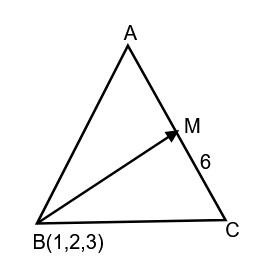
Compare the given equation with,
$\frac{x-x_0}{a}=\frac{y-y_0}{b}=\frac{z-z_0}{c}$
We get, $x_0=6,y_0=7,z_0=7,a=3,b=2,c=-2$
And write the point in parametrized form $(a\lambda+x_0,b \lambda+y_0, c \lambda+z_0)$
Let $\mathrm{M}(3 \lambda+6,2 \lambda+7,-2 \lambda+7)$
$\overrightarrow{\mathrm{BM}}=(3 \lambda+5) \hat{i}+(2 \lambda+5) \hat{j}+(-2 \lambda+4) \hat{k}$
$\overrightarrow{\mathrm{AC}} \cdot \overrightarrow{\mathrm{BM}}=0$
Since the dot product is zero, we can calculate the value of $\lambda$,
$0=3(3 \lambda+5)+2(2 \lambda+5)-2(-2 \lambda+4)$
$9\lambda+15+4\lambda+10+4\lambda-8=0$
$17\lambda=-17$
$\lambda=-1$
Now, put the value in the $\overrightarrow{BM}$,
$\overrightarrow{\mathrm{BM}}=(3 \times (-1)+5) \hat{i}+(2 \times(- 1)+5) \hat{j}+(-2 \times (-1)+4) \hat{k}$
$\overrightarrow{\mathrm{BM}}=2 \hat{i}+3 \hat{j}+6 \hat{k}$
Let us calculate the magnitude of this vector,
$|\overrightarrow{\mathrm{BM}}|=\sqrt{(2)^2+(3)^2+(6^2)}$
$|\overrightarrow{\mathrm{BM}}|=\sqrt{4+9+36}$
$|\overrightarrow{\mathrm{BM}}|=\sqrt{49}$
$|\overrightarrow{\mathrm{BM}}|=7$
We can calculate the area by using the formula:
Area $=\frac{1}{2} \times 6 \times 7=21 \text{ sq. units}$
Hence, the correct answer is 21.
NCERT Class 12 Maths Notes Chapter-Wise Links
For students' preparation, Careers360 has gathered all Class 12 Maths NCERT Notes here for quick and convenient access.
|
NCERT Class 12 Maths Chapter 10 Notes |
NCERT Exemplar Solutions Subject-Wise
After completing the NCERT textbooks, students should practice exemplar exercises for a better understanding of the chapters and clarity. The following links will help students find exemplar exercises.
NCERT Solutions Subject-Wise
These are links to the solutions of other subjects, which students can check to revise and strengthen those concepts.
NCERT Books and Syllabus
Students should always check the latest NCERT syllabus before planning their study routine. Also, some reference books should be read after completing the textbook exercises. The following links will be very helpful for students for these purposes.
Frequently Asked Questions (FAQs)
The key concepts in these NCERT Class 12 Maths Chapter 10 Notes include:
Types of vectors
Representation of vectors in component form
Dot product and cross product
Geometric applications such as the area of a triangle, a parallelogram
Conditions for collinearity and coplanarity
These NCERT Class 12 Maths Chapter 10 Notes can be considered as excellent revision material. But students need to practice the NCERT textbook concepts and exercises to build a strong base for the CBSE board exams. If you're preparing for competitive exams like the JEE, you should solve extra questions from reference books (like RD Sharma and Cengage).
Vector Algebra is very important and generally carries around 8–10 marks. It also forms the base for 3D geometry, so understanding it well helps in multiple chapters.
Dot product results in a scalar and is related to the projection of one vector on another.
Cross product results in a vector perpendicular to the plane containing both vectors.
Yes! Vector Algebra is widely used in physics for topics like force, motion, torque, electric field, and magnetic field. Mastering vectors makes physics problems much easier.
Popular Questions
Courses After 12th
Applications for Admissions are open.
As per latest syllabus. Physics formulas, equations, & laws of class 11 & 12th chapters
JEE Main Important Chemistry formulas
Get nowAs per latest syllabus. Chemistry formulas, equations, & laws of class 11 & 12th chapters
JEE Main high scoring chapters and topics
Get nowAs per latest 2024 syllabus. Study 40% syllabus and score upto 100% marks in JEE
JEE Main Important Mathematics Formulas
Get nowAs per latest syllabus. Maths formulas, equations, & theorems of class 11 & 12th chapters
